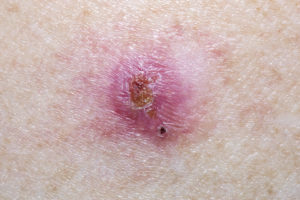Squamous Cell Carcinoma Treatment
in Glen Dale MD
What is squamous cell carcinoma?

Squamous cell carcinoma is the second most common form of skin cancer. It forms in the squamous cells that make up the middle and outer layers of the skin. Most squamous cell carcinomas result from prolonged exposure to ultraviolet radiation from the sun or tanning beds or lamps. Unlike basal cell carcinomas, squamous cell carcinomas can occur in more wide-ranging locations. Although more common on the sun-exposed skin on the backs of the hands, the ears, the scalp, and the lips, this form of skin cancer can occur anywhere on the body, including inside the mouth and on the genitals. Not considering life-threatening if treated early, like basal cell carcinoma, it can also be disfiguring. If it spreads, it can be life-threatening. Over 15,000 people in the U.S. die yearly from squamous cell carcinoma.
What causes squamous cell carcinomas to form?
With any cancer, cells grow abnormally fast, creating lesions or tumors. Squamous cell carcinomas develop when the flat, thin squamous cells in the outer layer of the skin develop errors in their DNA. When your skin is normal, new cells develop and they push older cells toward the skin surface. There they die and are shed. This is the process of exfoliation. When the DNA is damaged, however, the squamous cells grow out of control, forming a squamous cell carcinoma.
What do squamous cell carcinomas look like?
Squamous cell carcinomas appear as scaly, irritated skin. They are usually red and can be open sores. Sometimes they appear as elevated growths similar to warts. If left alone, they become larger and destroy tissue on the skin. Unlike basal cell carcinomas, squamous cell carcinomas can spread to other areas of the body.
What are the signs I have a squamous cell carcinoma?
Squamous cell carcinomas are more typical on sun-exposed skin: the scalp, the backs of the hands, the ears, and the lips. But this form of skin cancer can spread anywhere on your body.
Squamous cell carcinomas will have these characteristics:
- A firm, red nodule
- A flat sore with a scaly crust
- A new sore or raised area on an old scar
- A rough, scaly patch on your lip that can become an open sore
- A red sore or rough patch inside your mouth
- A red, raised patch or wart-like sore on or in the anus or on the genitals
How are squamous cell carcinomas treated?

In the vast majority of cases, when squamous cell carcinomas are detected early, they are relatively easy to treat. Once diagnosed, the patient shouldn’t wait to treat the lesion, as this form of skin cancer can spread. Generally, Dr. Callender and her team will employ the following options for treating squamous cell carcinoma.
Surgery
- Electrodesiccation and curettage — A curette is used to scrape out the growth, then the base is seared with an electric needle to close the blood vessels and destroy any remaining cancer cells. The squamous cell growth needs to be very small for this method to be used.
- Surgical excision — This involves cutting out the cancerous lesion with a scalpel, along with a margin of healthy skin around it. This is called the wide excision.
- Cryosurgery — Small, superficial squamous cell carcinomas can be frozen with liquid nitrogen.
- Mohs surgery — This method has the highest success rate of removing all of the squamous cell carcinomas. Dr. Callender does not perform Mohs surgery, but we will refer you to a specialist. The surgeon removes the squamous cell cancer layer by layer or ring by the ring around the growth. After a layer is removed, it is examined immediately to check for any remaining cancer cells on the borders. If cancer cells are still found, another layer or ring is removed. This process is continued until the sample shows itself to be clean. This is especially effective for removing growths on the lips, as only the minimum amount of tissue is removed.
Drugs
Although the squamous cell carcinoma needs to be relatively small and superficial, topical treatments can be successful. This is a more recent approach to treatment. These drugs work by inflaming the area where they are applied. The body responds by sending white blood cells to attack the inflammation. These white blood cells go after the mutated squamous cells. Aldara, Efudex, and Fluoroplex are three of the most used drugs.
What is the success rate for treating squamous cell carcinoma?

Unlike basal cell carcinoma, squamous cell carcinoma tends to be more invasive and is likely to spread if left untreated. Mohs micrographic surgery has the best success rates, at 97 percent. Excision has a 92 percent success rate. For low-risk, small tumors, curettage, and electrodesiccation are successful in 96 percent of cases, but it cannot be used for larger, deeper growths.
Squamous cell carcinoma is generally not considered life-threatening if treated early. However, if left untreated, squamous cell carcinoma can spread and it can then become life-threatening. Reliable statistics are not available, however, because most of these cancers are treated in a dermatologist’s office.
Where on the body can I develop squamous cell carcinomas?
These lesions most commonly form on sun-exposed areas of the body, such as the arms, hands, scalp, shoulders, neck, lips, and ears. But they can form in areas that don’t receive sun exposure, including the genitals and the bottoms of your feet.
Patient Review
“I saw Dr. Young. She is attentive and informative and really cares about the progress of my skincare.”
“Very professional and friendly and the staff and Drs know what they are doing. Would refer to anyone who needs comprehensive skincare.”
Schedule a Consultation Today!
If you’re interested in learning more about squamous cell carcinomas please contact us for a consultation at 301.249.0970 or fill out our contact us form below. We will discuss your needs and concerns, and determine your best course of action.


